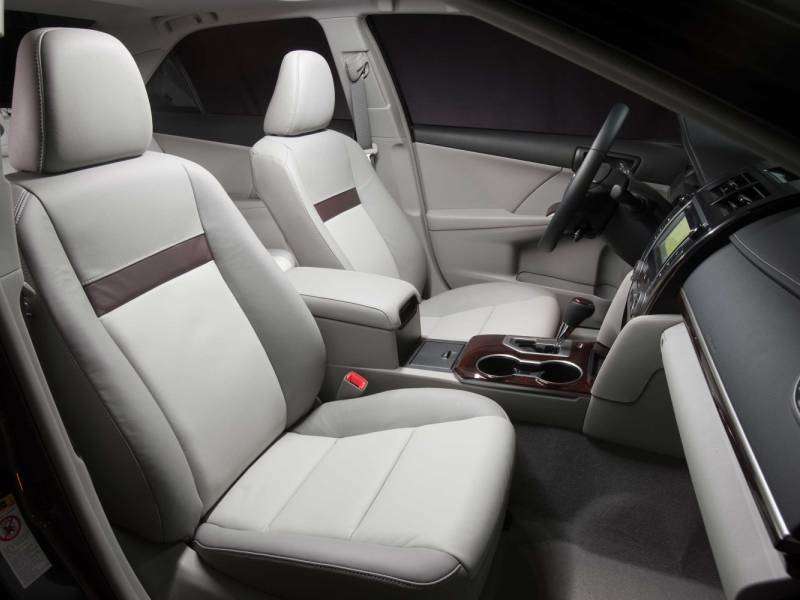Recent Articles
Popular Makes
Body Types
2013 Toyota Camry Road Test & Review
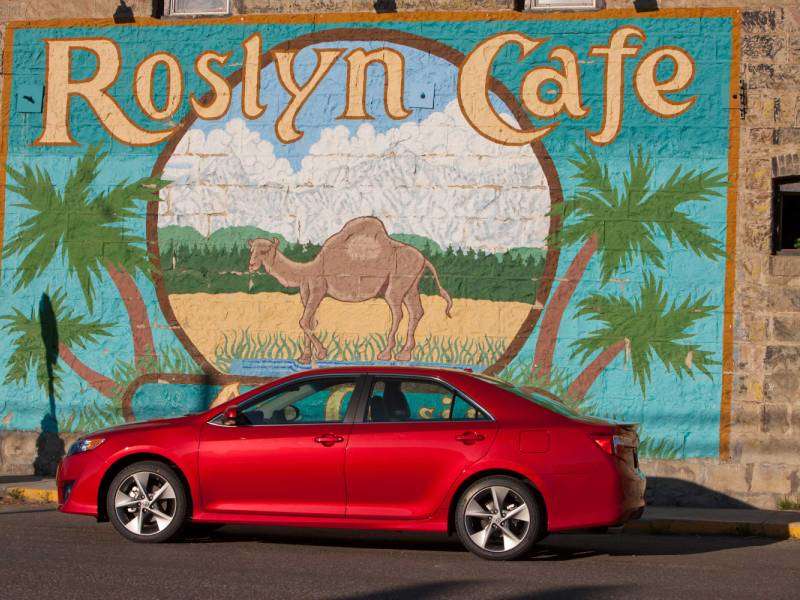
The introduction of a new Toyota Camry model is an occasion typically greeted with about as much verve as finding a television set in your hotel room. You know it’s going to be there, you know what to expect from it, and you aren’t surprised when it performs exactly as you expect it to.
That is, unless you’re a Toyota dealer, in which case you hungrily start licking your chops in anticipation of your share of the many hundreds of thousands of sales the new Camry will average in the United States alone. In other words, while those who consider themselves firmly established among the automotive cognoscenti sneer at the perceived blandness of Toyota’s mid-size sedan, a very huge swath of the American public demonstrates year in and year out it would rather drive a Camry than anything else on the road—and, by a huge margin.
In a typical year, Toyota will move some 400,000 Camry automobiles. So if it seems like you see a Camry pretty much everywhere you go—it’s because you do. Against this backdrop, we began our test of the 2013 Toyota Camry—once someone helped us find it in the parking lot. By that we mean you pretty much have to park the 2011 Camry and the 2013 Camry side-by-side to see the differences between the two.
Don’t get us wrong, they’re there, but over the years, Toyota has demonstrated a decided knack for evolving its best-selling car, rather than revolutionizing it, and to tremendous effect. The good news is the product planners have finally realized they don’t have to make the Camry bland to ensure it doesn’t offend anyone. Fresh off a redesign for the 2012 model year, the latest Camry models are now as interesting as they are proficient.
New features for the 2013 model year include rear cross traffic alert for models equipped with Blind Spot Monitoring, soft touch materials for the LE and SE trimmed automobiles, as well the addition of the Display Audio screen to the base L model.
2013 Toyota Camry Road Test & Review: Models & Prices
Toyota is offering the Camry in four trim levels for 2013. The base trim package is the Toyota Camry L. Ascending through the range; the next models you’ll encounter are Camry LE, SE, and XLE.
Standard features on the $22,235 Toyota Camry L are projector beam halogen headlights, daytime running lights, power adjustable outside mirrors, with color-keyed manual folding housings, 16-inch steel wheels, intermittent wipers, and a six-speed automatic transmission.
You’ll also find air conditioning, as well as a 6.1-inch touch-screen display for the six-speaker audio system—incorporating an AM/FM receiver with a CD player, iPod connectivity, an auxiliary audio input, a USB port, and Bluetooth handsfree phone capability and audio streaming.
The seats in the Toyota Camry L are upholstered in cloth and are manually adjustable six ways for the driver—four ways for the front passenger. The rear seat folds 60/40. It also features an armrest with a cup holder and a pass-through to the trunk.
Cruise control is a standard feature, along with a tilt and telescoping steering wheel. On the wheel, you’ll find controls for the audio system and the Bluetooth phone connection. Instrumentation includes an analog speedometer, tachometer, fuel, and average fuel economy gauges; an LCD display reports the odometer, trip meters, outside temperature, and shift-position indications.
The Camry L’s power windows feature auto up/down for the driver with jam protection, and retained power so they’ll operate for a while after you shut the Camry’s engine off. The base Camry model also comes with a rear window defogger, a day/night rearview mirror, an overhead console with map lights and sunglass storage, a covered center console with an adjustable armrest, an illuminated glove compartment, a 12V power outlet, sliding extensions for the sun visors, and eight cupholders.
The $22,680 Toyota Camry LE adds automatic headlights; power door locks with remote keyless entry, an optional moonroof, and optional power adjustments for the front seats.
If you opt for the $23,400 Camry SE, you can choose between four-cylinder and V6 power. You’ll also get a sport tuned suspension system, 17-inch wheels (with the four-cylinder engine), foglights, a leather wrapped steering wheel, sport seats, and a more sporting exterior treatment. If you go with the V6 engine, you’ll get 18-inch wheels in addition to keyless entry/ignition, navigation, voice recognition, and Toyota’s Internet enabled Entune system. Blind spot monitoring is available as an option.
Move to the top of the line, $24,855 (four-cylinder)/ $30,465 (V6) XLE model and things start to get decidedly Lexus-like with a nice wood grain interior trim leading the way. You’ll find heated exterior mirrors and a sunroof as standard equipment. XLE trimmed Camry models also get dual-zone automatic climate control, an eight-way adjustable power driver’s seat and Entune. With the V6 engine, you’ll also get a rearview camera, an autodimming rearview mirror, and leather as a standard feature. The XLE also provides a power-adjustable seat for the front passenger—and of course heated front seats. A Homelink universal transceiver will open your garage door and security gates, and your steering wheel will be trimmed in leather.

2013 Toyota Camry Road Test & Review: Design
As we mentioned before, the Toyota Camry’s main mission in terms of styling is to be as likable as possible—to as broad a segment of the population as possible. Now, with that said, this doesn’t have to mean the car is exceptionally good looking. In fact, there have been some downright homely Camry models offered over the years that still sold really well. What this generally means is the Camry blends into the background—calling no undue attention to itself.
That said; the stance of the current Camry design is wider and lower than the 2011 model it replaced. Its lines are crisply angular, but softly rounded at the edges. Remarkablyeach succeeding generation of the Camry grows just a bit in size over its predecessor—exterior-wise.
Yet, through innovative packaging, the company’s engineers always manage to find more room inside the car. So much so, each succeeding generation of the Camry seemingly boasts a more spacious interior.
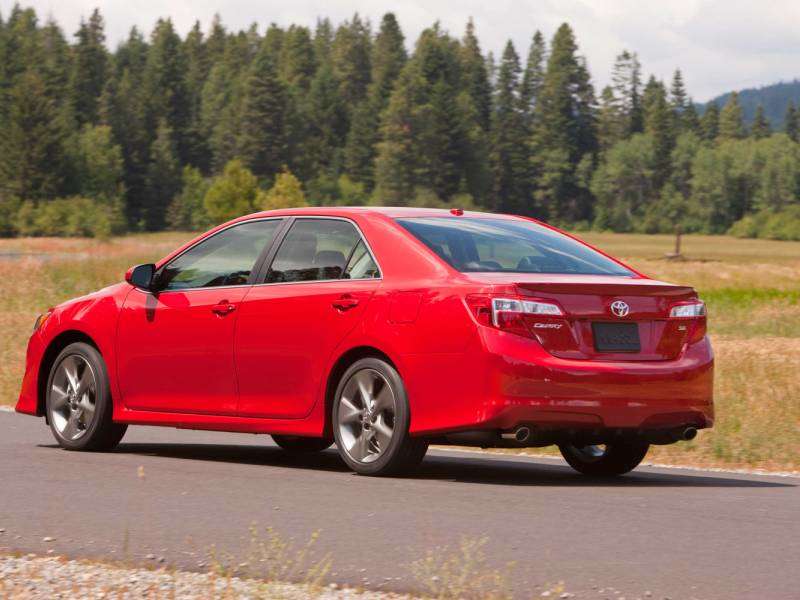
2013 Toyota Camry Road Test & Review: Comfort & Cargo
Another remarkable feat is the way the Toyota Camry always manages to pick up more equipment, without gaining weight. In fact, this current version, while considerably better equipped than the one it replaced, is some 110 pounds lighter than the previous version.
So, while those who measure a car’s worth in 0-60 times, quarter-mile numbers, slalom speeds, and G’s pulled on the skidpad are sneering at the “blandness” of the Camry, each succeeding generation of the car actually represents ever more significant achievements in engineering.
And with that said, definitive steps have been taken to reduce the Camry’s always low noise levels, while improving the aerodynamics and impressive ride too.
As you'd well expect, trunk space and storage are more than abundant. Even though it is a mid-sized sedan, the Camry functions exceptionally well as a family car.
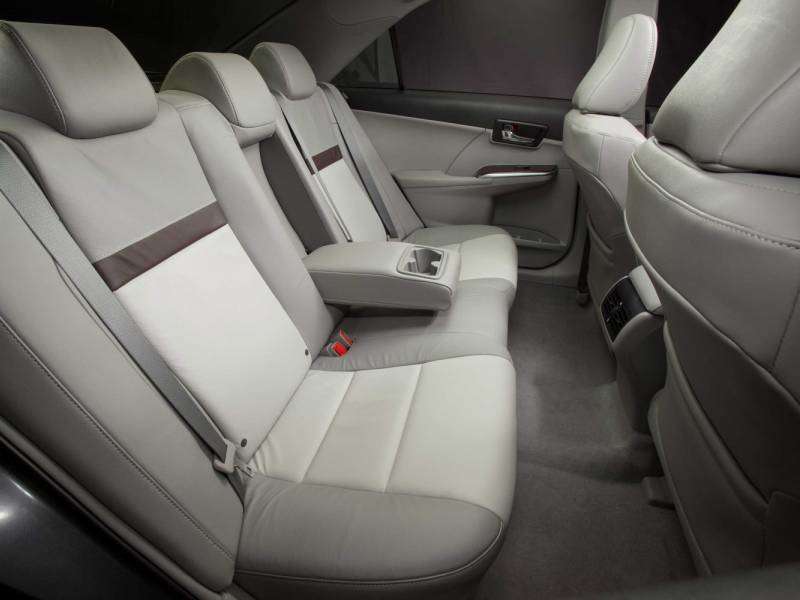
2013 Toyota Camry Road Test & Review: Features & Controls
If there’s one place the Camry truly shines it’s the interior.
The soft-touch materials employed are first-rate, the overall design is pleasing to the eye, and the ergonomics are outstanding. Pairing a Bluetooth device to the 2013 Toyota Camry’s Display Audio infotainment system is so intuitive it’s almost telepathic and the capabilities are absolutely amazing.
Streaming audio, news, traffic information, weather, and practically anything else you might reasonably have a need for in an automobile, Toyota’s Entune telematics system is outstanding in its ability to work in conjunction with the pertinent applications of your smartphone. Further, the optional seven-inch Premium Hard Disc Drive Navigation system can be configured with a split-screen to display navigation and audio system information simultaneously.
The upper level models offer some truly impressive sounding audio systems too. The JBL GreenEdge audio system for example, combines an eight-channel amplifier and door-mounted acoustic lens speakers. It is 66 percent smaller than the comparable audio system previously employed in the Camry; it also sounds 50 percent better—and uses less power.
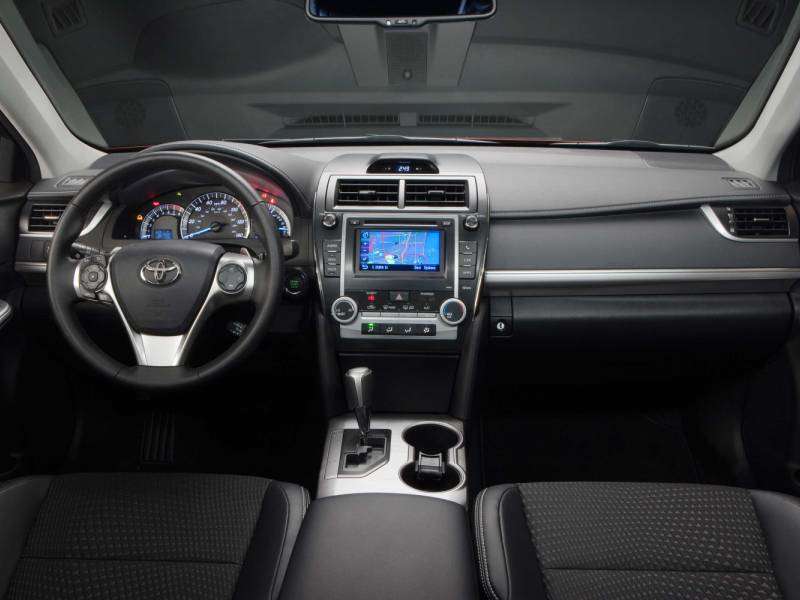
2013 Toyota Camry Road Test & Review: Engines/Fuel Economy
The engines are pretty much carried over from the previous generation of the Toyota, however they do enjoy a number of engineering enhancements for improved fuel efficiency.
A six-speed automatic transmission routes power from both the 268-horsepower, 3.5-liter V6 and the 170-horsepower inline four. The V6 produces 248 ft-lbs of torque, while the inline-four delivers 170 ft-lbs of twisting force.
The V6 returns 21 miles per gallon in the city, 31 on the highway and 25 mpg combined. The four is capable of delivering 25 in the city, 35 on the highway, and 28 miles per gallon combined.
One of the really nice things about the way the Toyota product planers have configured the Camry’s trim offerings is you can get either engine with both of the upper trim packages. This way, if you prefer the sporty look of the SE model, or the extra luxury features of the XLE model, you can have them—while still enjoying the superior fuel economy of the Camry’s four-cylinder engine offering
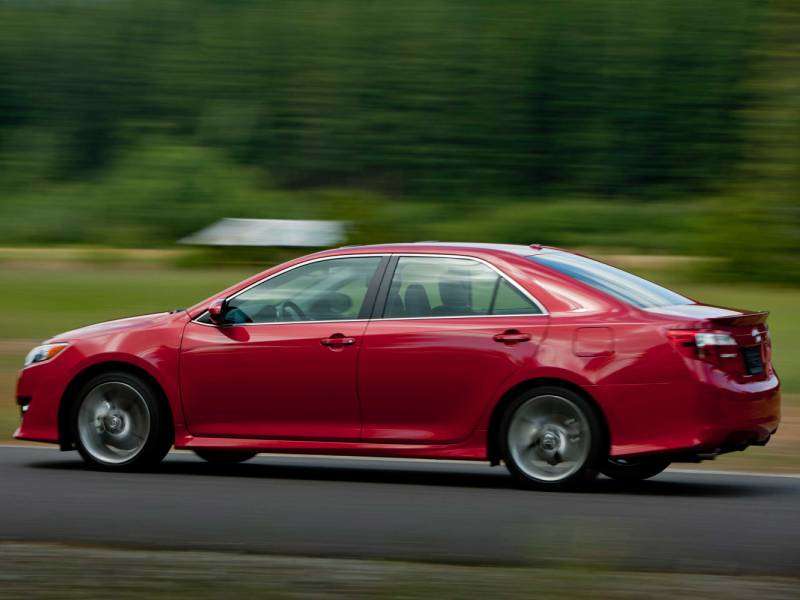
2013 Toyota Camry Road Test & Review: Driving Impressions
Another significant improvement the Camry enjoys is in the handling department—particularly with the more performance oriented SE trim package. Living up to the promise of its body kit, more supportive seats, revised steering calibration, and three-spoke steering wheel, the SE demonstrates remarkable balance and roadholding thanks to its firmer version of the Camry’s new suspension system.
And, while BMW is under no significant threat from the Toyota, it is absolutely a vast improvement over the Camry SE it replaces. Similarly, the mainstream 2012 Camry models offer more engaging driving dynamics as well. The Camry now feels as if it enjoys being driven, rather than dutifully complying in the manner of a dispassionate English servant.
And, it does this while sacrificing nothing in ride comfort.
Now with that said, please note we mean better handling in comparison to earlier models of the Camry. Anybody approaching this Toyota looking for the reflexes of a world-class sport sedan is shopping at the wrong dealership. In this price category, those traits will be found in more abundance at your local Nissan store—wearing an Altima badge.
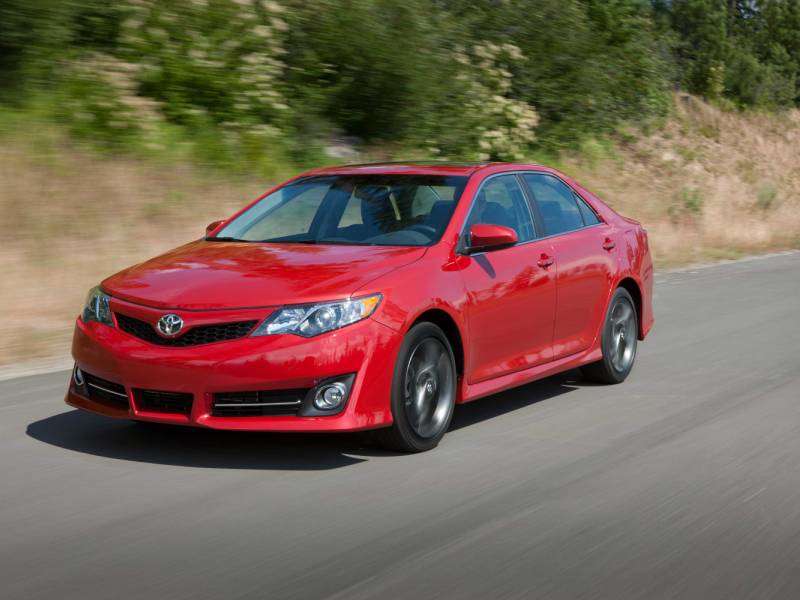
2013 Toyota Camry Road Test & Review: Safety Equipment
Regardless of the trim level you choose, you’ll get 10 airbags as standard equipment. The front airbags are dual-stage advanced SRS units. You’ll also find front and rear seat-mounted side airbags, side curtain airbags, and a knee bag for the front passenger.
Toyota’s Star Safety System includes Vehicle Stability Control, Traction Control, Anti-lock Braking, Electronic Brake-force Distribution, and Brake Assist. The Star Safety System also incorporates Toyota’s Smart Stop Technology brake-override system. Electronic tire pressure monitoring is standard equipment as well.
Toyota’s optional Safety Connect system accesses a call center with a live operator who can dispatch police and emergency vehicles. Safety Connect also combines automatic collision notification and a stolen vehicle locator feature to track the location of the Camry via GPS to help guide the police and emergency assistance to its location.
The 2013 Toyota Camry’s optional Blind Spot Monitor will reveal vehicles in the driver’s blind spots. When the system detects a vehicle in the adjacent lane, it will illuminate indicators on the corresponding side mirror. When the driver activates a turn signal to indicate a lane change, if there is a vehicle in the blind spot of the driver’s intended lane, the indicator on the corresponding mirror will flash.
This system also now incorporates rear cross traffic alert. This can be especially helpful when backing out of a driveway or a parking space if another vehicle is approaching outside the driver’s line of vision.
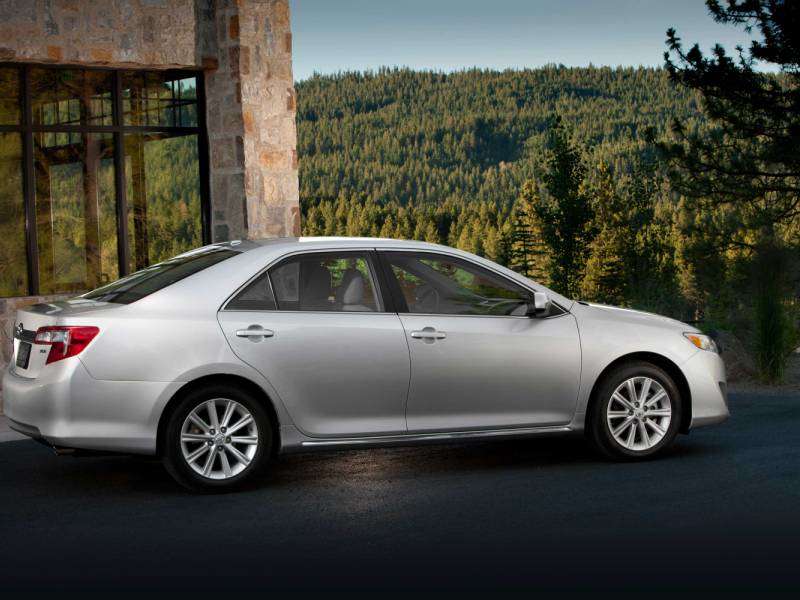
2013 Toyota Camry Road Test & Review: Final Thoughts
Clearly Toyota is serious about maintaining the leadership position of its bread and butter sedan. While the competition has made great strides toward approaching and surpassing the Camry in the past few years, with this car, Toyota continues to demonstrate the real advantage of having the leadership position is when you improve what you’re already working with you leap out far ahead of the crowd once again.
And that’s just exactly what the 2013 Camry does.
Now, if we could just find ours in the parking lot, it’d be just about perfect.

2013 Toyota Camry Road Test & Review: Pros & Cons
• Crisp styling
• Spacious Interior
• Generous array of standard features
• Anonymous styling
• A broad palette of very strong competitors

